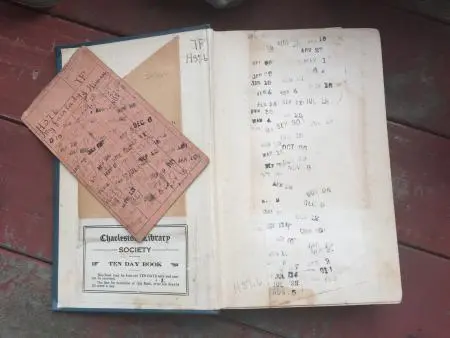Out of Circulation
I work in an old library. In fact, it's the second oldest circulating library in the country, and has existed in various formats and spaces since 1748.
1748.
That's a long time, y'all.
Our vaults are jam-packed with colonial newspapers, collections of letters and journals from the 1800s, and crazy-cool historical artifacts. Our stacks are stuffed with books, and while our librarians do their best to keep the latest books coming in, some of the books in the stacks are...shall we say...old.
Outdated.
Some of them haven't been checked out for decades, and I'm not exaggerating.
Lately one of our librarians has been culling the stacks, cataloging what we have (since much of what we have is still tracked on handwritten cards in the card catalog). Thus, there have been epic piles of old, out-of-print books hanging around our shared office space lately, and the smell alone is thrilling.
But as she pulls books out of circulation, some of which haven't been touched this century, I wonder: do these books still have things to teach us? Or are they as archaic as they look, with nothing left to offer us contemporary souls?
I decided to investigate. I pulled a couple of books at random, their dust jackets long since tossed, their spines cracked with age, and I checked them out.
'My Fair Lady' by Louis Hemon
I selected a blue book first for no reason other than I recognized the title: My Fair Lady. I knew it wasn't a novelization of the Audrey Hepburn classic, and I knew the play-version of that movie was called Pygmalion. But still. That one little bit of familiarity drew me to it.
The author was someone named Louis Hemon. A quick Google search told me he was French, but that he also lived in Canada and the United States at the turn of the last century. Very cool. He was moderately famous at the time for a novel called Maria Chapdelaine, which has remained in print throughout the ages, but nowhere could I find evidence of My Fair Lady.
That said, it was clearly quite popular at some point. The edition I carried home was published by MacMillan Company in New York in 1923. Originally written in French, this was a translation by a William Aspenwall Bradley, and the checkout card and first blank page are covered in due date stamps. Many, many hands have held this book.
The book itself is no mass market paperback. No. It's a hardcover, sewn and not glued. It smells exactly like an old book should — musty, dusty, and delicious. The very experience of holding it, turning the pages (much thicker than those used in contemporary bindings) was lovely. Every book lover should take the time to leaf through an antique book. It's so very yummy.
So how about the words, right? Are you wondering about them? What was the book about?
Well, it was a surprise alright. For one, My Fair Lady is a short story collection, named for the first story in the collection. I'd honestly been hoping for a novel, but once I started, I was sucked in quite quickly.
The collection is short — only 226 pages, and those pages use a fairly large typeset that was probably more popular back in the day (reading by candlelight is hard, y'all!). There are seven short stories and one novella, and they're all...interesting.
There's "My Fair Lady," the first, in which two men mourn a lost youth, and a lost love.
There's "He-Who-Sees-The-Gods," about a foreigner who comes to town and shows a Catholic priest there might be another way of thinking about God(s) and morality.
In "The Last Evening," three friends party all night long to stave off an upcoming, poor-economy-driven separation.
"The Old Woman" speaks of death as relief.
"The Destiny of Miss Winthrop-Smith" muses on "all the inestimable things which are thrown away in a day, and which never return." (In this case, a future husband, a life away from the city, and the possible loss of a beloved career.)
"Truth Fair" follows a Jewish man who debates "truth" with evangelicals who want to save him.
And in "Fear," the depths of a lake hold secrets that two men are too afraid to unlock.
Finally, "Lizzie Blakeston," the novella, follows a beautiful little girl from the wrong part of town, and all the ways life tries to break her, and all the ways she fights back.
So here's what got me, and what gets me still as I write those tiny summations of each of Hemon's stories: they all could have been written today. Sure, the details might have been different (I don't know many girls who wear velvet dresses and carry parasols for a night out with their pals, for example), and the religions of the characters, perhaps. But the themes? The ideas he explored? They're still things we're all wrestling with today.
Maybe, probably, if it was written today, the Jewish man would be Muslim. But what person of an "other" religion hasn't been approached about being saved by someone who thinks they know better? I sure have — a coworker once signed me up for Jews for Jesus, and it took me three years to get off their mailing list.
What person doesn't fear death, and hope to find, in the end, it's nothing but sweet relief.
Who hasn't stayed up all night, hoping to hold onto their childhood just a little bit longer.
Almost a hundred years have passed since the publication of this collection of stories. Times have changed. Values have supposedly changed. We're facing a tough economy, war, terrorism, you name it.
But you know what? So were the people a century ago. They worried about the same things as us. Outsiders, religion, money, creatures beyond our understanding.
People are people. We change, but we also don't.
Reading My Fair Lady by Louis Hemon has to have been one of the more comforting experiences of my recent existence. We are going through rough times, yes. But our ancestors did, as well, and we, like them, will persevere.
And we'll write about it, too. Because we, my friends, are the writers. Rawr.

About the author
Leah Rhyne is a Jersey girl who's lived in the South so long she's lost her accent...but never her attitude. After spending most of her childhood watching movies like Star Wars, Aliens, and A Nightmare On Elm Street, and reading books like Stephen King's The Shining or It, Leah now writes horror and science-fiction. She lives with her husband, daughter, and a small menagerie of pets.










